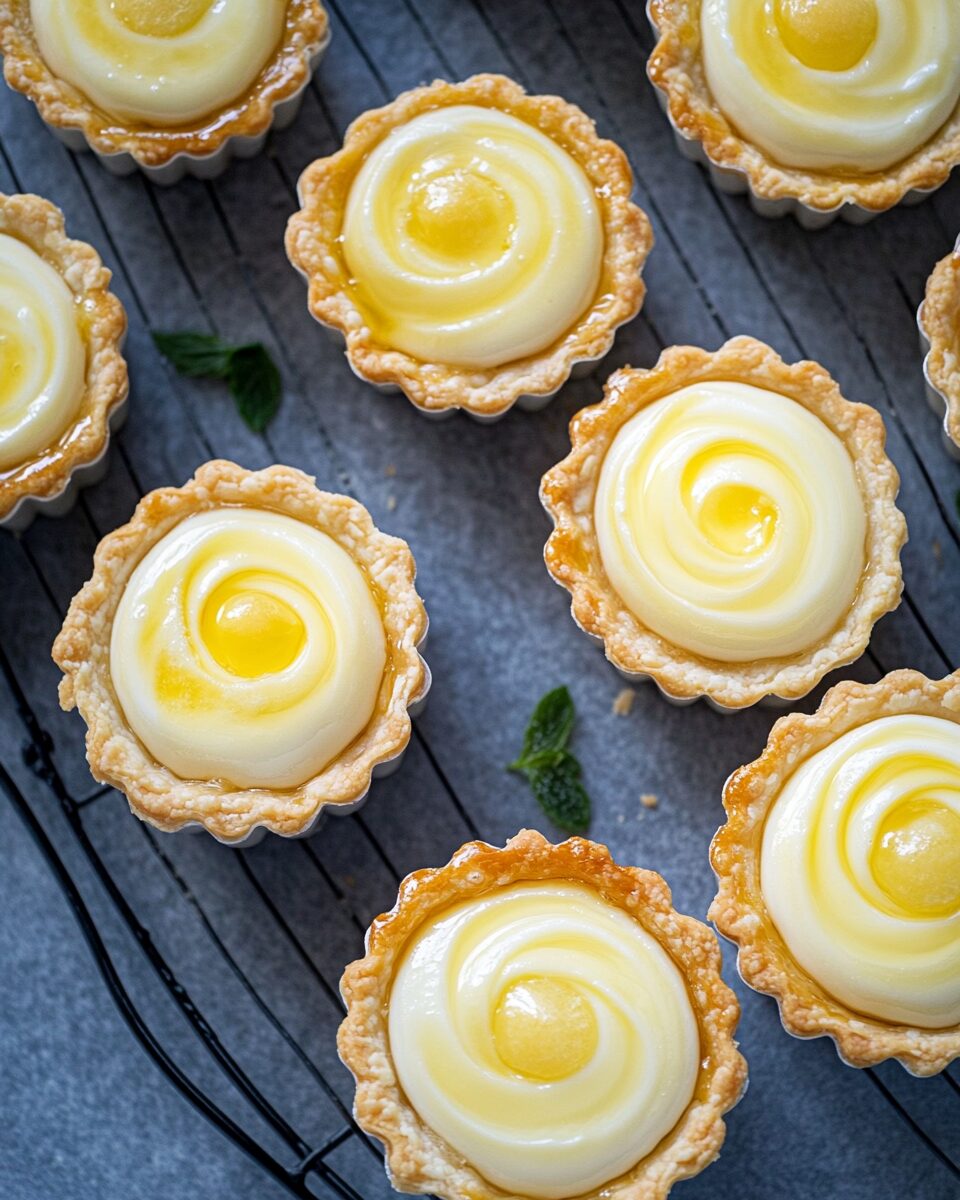Japanese Cheese Tarts, also known as Hokkaido cheese tarts, are a delightful dessert featuring a buttery, flaky tart shell filled with a rich, creamy cheese filling.
FULL RECIPE:
Ingredients
- For the Tart Shells:
- 1 1/2 cups all-purpose flour
- 8 1/2 tablespoons unsalted butter, cubed
- 1/2 cup powdered sugar
- 1 egg yolk
2. For the Cheese Filling:
- 1 cup cream cheese, softened
- 1/2 cup powdered sugar
- 2/3 cup heavy whipping cream
- 1 teaspoon cornstarch
3. For the Egg Wash:
- 1 egg yolk
- 1/2 tablespoon milk or water
Directions
- Prepare the Tart Shells: In a bowl, combine all-purpose flour and powdered sugar. Add chilled butter cubes and mix using an electric hand whisk until the mixture resembles coarse crumbs. Add the egg yolk and continue mixing until the dough comes together. Knead gently with your hands until smooth. Divide the dough into portions and press each into a 2.6-inch mini tart mold, ensuring an even layer. Trim any excess dough from the edges. Preheat the oven to 410°F (210°C). Bake the tart shells for 15 minutes or until golden brown. Remove from the oven and let them cool before removing from the molds.
- Prepare the Cheese Filling: In a bowl, mix softened cream cheese and powdered sugar until smooth. Gradually add heavy whipping cream in three portions, mixing well after each addition. Sift in the cornstarch and mix until fully incorporated. Transfer the cheese filling to a piping bag.
- Assemble and Bake: Pipe the cheese filling into the cooled tart shells, filling them generously. Place the filled tarts in the freezer for about 4 hours or until firm. Preheat the oven to 410°F (210°C). Prepare the egg wash by mixing the egg yolk with milk or water. Brush the top of each tart with the egg wash. Bake the tarts for 15 minutes or until the tops are golden brown. Let the tarts cool slightly before serving. Enjoy them warm for a molten center, chilled for a custard-like texture, or frozen for a refreshing treat.
Nutrition Facts
- Calories: 230 kcal
-
Total Fat: 18 g
- Saturated Fat: 10 g
- Cholesterol: 90 mg
- Sodium: 90 mg
-
Total Carbohydrates: 20 g
- Dietary Fiber: 1 g
- Sugars: 10 g
- Protein: 5 g
- Calcium: 40 mg
The Origins of Japanese Cheese Tarts
Japanese Cheese Tarts are believed to have been inspired by Portuguese egg tarts and Western cheesecakes. However, the concept of a baked cheese tart with a gooey center gained traction in Japan, particularly in Hokkaido, where local bakeries started perfecting their own versions of this delightful treat. The global rise in popularity can largely be credited to Bake Cheese Tart, a Japanese bakery chain that brought these tarts to international fame. They expanded beyond Japan, with locations in several Asian countries and even parts of North America and Australia. The main difference between Japanese cheese tarts and other similar desserts, such as Portuguese pastéis de nata or Hong Kong-style egg tarts, is the cheese-based filling. Instead of a custard center, Japanese cheese tarts focus on a creamy, cheesecake-like filling that remains slightly molten when eaten warm. This distinction makes them a one-of-a-kind dessert that appeals to those who enjoy both cheesecakes and pastries.
Texture and Flavor Profile
One of the defining features of Japanese cheese tarts is their complex texture. When fresh out of the oven, the filling remains molten and oozes slightly when bitten into. If allowed to cool, the filling sets into a smooth, creamy consistency similar to that of a classic cheesecake. When chilled, the filling becomes firmer and more structured, while freezing the tart gives it an almost ice cream-like texture. This versatility allows individuals to enjoy the tarts in various ways based on their preference. Flavor-wise, Japanese cheese tarts strike a perfect balance between sweet and savory notes. The rich, slightly tangy cheese filling is complemented by a touch of sweetness, ensuring that the tart does not become overwhelmingly sugary. Some variations of these tarts include additional ingredients such as vanilla, lemon zest, or honey to enhance the depth of flavor. The tart crust, which is made with butter, flour, and sugar, adds a delightful contrast to the softness of the filling by providing a slightly crunchy bite.
Serving Suggestions and Variations
Japanese cheese tarts are incredibly versatile and can be enjoyed in different ways. The most common way to serve them is fresh out of the oven when the cheese filling is still warm and gooey. However, some people prefer to refrigerate the tarts, allowing the filling to firm up slightly for a more traditional cheesecake-like texture. Freezing the tarts transforms them into a rich, frozen treat that resembles a cheese-flavored ice cream pastry. Many bakeries and home bakers experiment with different flavors to add a unique twist to the classic cheese tart. Some popular variations include matcha cheese tarts, which incorporate Japanese green tea powder for an earthy undertone, and chocolate cheese tarts, where cocoa powder or melted chocolate is blended into the filling. Another popular variation is fruit-infused cheese tarts, which feature a layer of fruit jam, such as raspberry or blueberry, to add a hint of tartness. Seasonal variations, such as pumpkin or yuzu cheese tarts, also make appearances in specialty bakeries, offering new flavors to try throughout the year.
Why Japanese Cheese Tarts Are So Popular
The widespread popularity of Japanese cheese tarts can be attributed to their irresistible texture, balanced flavors, and the trend of Japanese-style desserts gaining global recognition. Many food enthusiasts appreciate the meticulous attention to detail that goes into crafting these tarts, as well as the premium ingredients often used in their preparation. Additionally, the ability to customize the texture based on serving temperature makes them appealing to a broad range of preferences. Another factor contributing to their popularity is the growing demand for high-quality, handcrafted baked goods. Japanese bakeries are known for their commitment to precision and quality, which has helped elevate the reputation of cheese tarts beyond Japan. Social media has also played a significant role in the tart’s rise to fame, with food bloggers and influencers showcasing their beautifully baked, golden-brown tarts to millions of followers worldwide. The trend of “Instagrammable” food has further boosted the appeal of these tarts, making them a must-try dessert for food lovers everywhere.
Health Considerations and Nutritional Value
While Japanese cheese tarts are undeniably delicious, they should be enjoyed in moderation due to their high-calorie and high-fat content. The combination of butter, heavy cream, and cream cheese results in a dessert that is rich in saturated fats. However, they also provide a good amount of protein and calcium, making them a more indulgent yet somewhat beneficial treat compared to many other pastries. For those looking for a healthier alternative, some variations use reduced-fat cream cheese or substitute part of the cream with Greek yogurt. Additionally, using almond flour or whole wheat flour for the tart crust can slightly improve the nutritional profile while maintaining a delicious taste and texture. Some bakers also experiment with sugar substitutes such as honey or stevia to reduce the sugar content.
Conclusion
Japanese Cheese Tarts have captivated dessert lovers worldwide with their creamy, melt-in-your-mouth texture and perfectly balanced flavor. Originating from Hokkaido, Japan, these delightful treats have become a global sensation, thanks to their versatility and unique taste experience. Whether eaten warm, chilled, or frozen, each bite offers a different yet equally satisfying texture.






